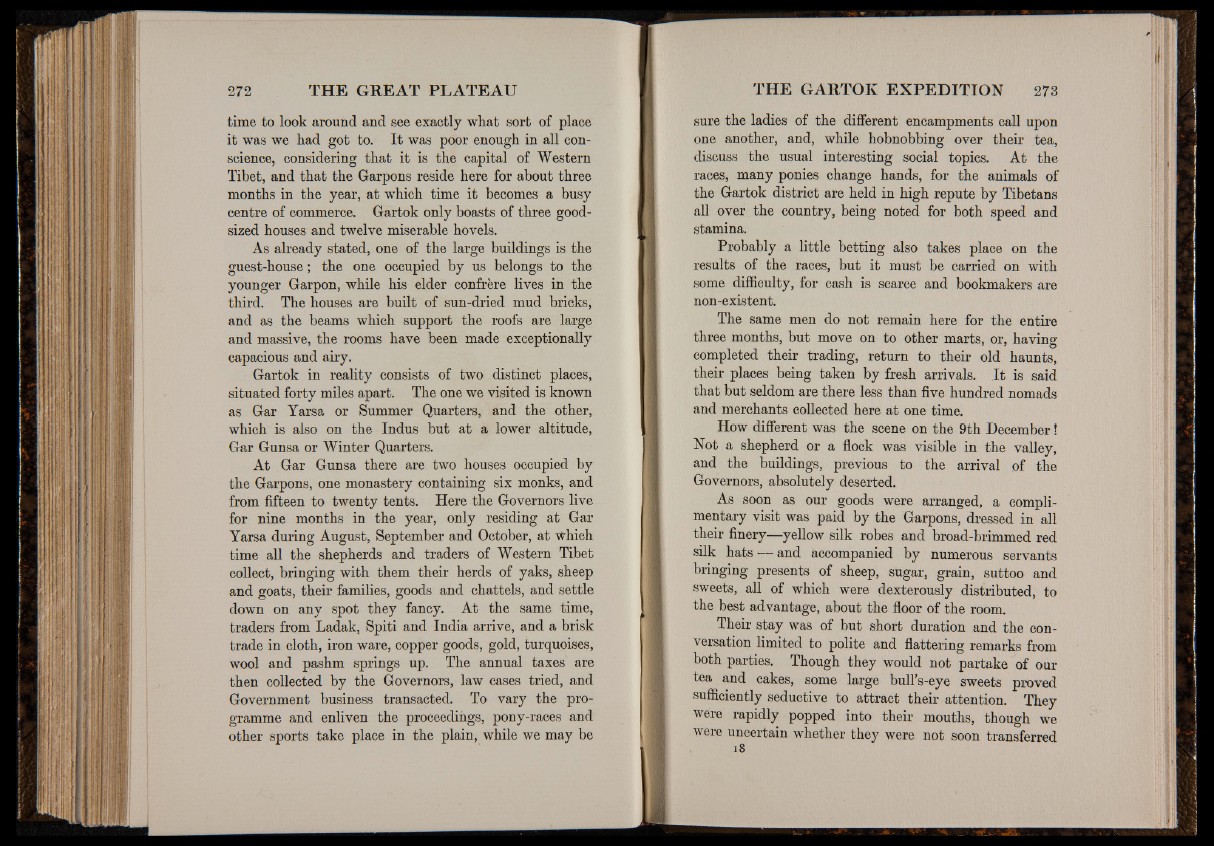
time to look around and see exactly what sort of place
it was we had got to. It was poor enough in all conscience,
considering that it is the capital of Western
Tibet, and that the Garpons reside here for about three
months in the year, at which time it becomes a busy
centre of commerce. Gartok only boasts of three good-
sized houses and twelve miserable hovels.
As already stated, one of the large buildings is the
guest-house; the one occupied by us belongs to the
younger Garpon, while his elder confrere lives in the
third. The houses are built of sun-dried mud bricks,
and as the beams which support the roofs are large
and massive, the rooms have been made exceptionally
capacious and airy.
Gartok in reality consists of two distinct places,
situated forty miles apart. The one we visited is known
as Gar Yarsa or Summer Quarters, and the other,
which is also on the Indus but at a lower altitude,
Gar Gunsa or Winter Quarters.
At Gar Gunsa there are two houses occupied by
the Garpons, one monastery containing six monks, and
from fifteen to twenty tents. Here the Governors live
for nine months in the year, only residing at Gar
Yarsa during August, September and October, at which
time all the shepherds and traders of Western Tibet
collect, bringing with them their herds of yaks, sheep
and goats, their families, goods and chattels, and settle
down on any spot they fancy. At the same time,
traders from Ladak, Spiti and India arrive, and a brisk
trade in cloth, iron ware, copper goods, gold, turquoises,
wool and pashm springs up. The annual taxes are
then collected by the Governors, law cases tried, and
Government business transacted. To vary the programme
and enliven the proceedings, pony-races and
other sports take place in the plain, while we may be
sure the ladies of the different encampments call upon
one another, and, while hobnobbing over their tea,
discuss the usual interesting social topics. At the
races, many ponies change hands, for the animals of
the Gartok district are held in high repute by Tibetans
all over the country, being noted for both speed and
stamina.
Probably a little betting also takes place on the
results of the races, but it must be carried on with
some difficulty, for cash is scarce and bookmakers are
non-existent.
The same men do not remain here for the entire
three months, but move on to other marts, or, having
completed their trading, return to their old haunts,
their places being taken by fresh arrivals. It is said
that but seldom are there less than five hundred nomads
and merchants collected here at one time.
How different was the scene on the 9th December!
Not a shepherd or a flock was visible in the valley,
and the buildings, previous to the arrival of the
Governors, absolutely deserted.
As soon as our goods were arranged, a complimentary
visit was paid by the Garpons, dressed in all
their finery—yellow silk robes and broad-brimmed red
silk hats — and accompanied by numerous servants
bringing presents of sheep, sugar, grain, suttoo and
sweets, all of which were dexterously distributed, to
the best advantage, about the floor of the room.
Their stay was of but short duration and the conversation
limited to polite and flattering remarks from
both parties. Though they would not partake of our
tea and cakes, some large bull’s-eye sweets proved
sufficiently seductive to attract their attention. They
were rapidly popped into their mouths, though we
weie uncertain whether they were not soon transferred
18